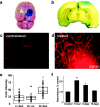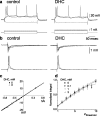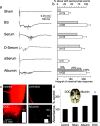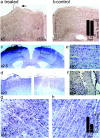Lasting blood-brain barrier disruption induces epileptic focus in the rat somatosensory cortex
- PMID: 15356194
- PMCID: PMC6729929
- DOI: 10.1523/JNEUROSCI.1751-04.2004
Lasting blood-brain barrier disruption induces epileptic focus in the rat somatosensory cortex
Abstract
Perturbations in the integrity of the blood-brain barrier have been reported in both humans and animals under numerous pathological conditions. Although the blood-brain barrier prevents the penetration of many blood constituents into the brain extracellular space, the effect of such perturbations on the brain function and their roles in the pathogenesis of cortical diseases are unknown. In this study we established a model for focal disruption of the blood-brain barrier in the rat cortex by direct application of bile salts. Exposure of the cerebral cortex in vivo to bile salts resulted in long-lasting extravasation of serum albumin to the brain extracellular space and was associated with a prominent activation of astrocytes with no inflammatory response or marked cell loss. Using electrophysiological recordings in brain slices we found that a focus of epileptiform discharges developed within 4-7 d after treatment and could be recorded up to 49 d postoperatively in >60% of slices from treated animals but only rarely (10%) in sham-operated controls. Epileptiform activity involved both glutamatergic and GABAergic neurotransmission. Epileptiform activity was also induced by direct cortical application of native serum, denatured serum, or albumin-containing solution. In contrast, perfusion with serum-adapted electrolyte solution did not induce abnormal activity, thereby suggesting that the exposure of the serum-devoid brain environment to serum proteins underlies epileptogenesis in the blood-brain barrier-disrupted cortex. Although many neuropathologies entail a compromised blood-brain barrier, this is the first direct evidence that it may have a role in the pathogenesis of focal cortical epilepsy, a common neurological disease.
Figures







Comment in
-
A possible causative role for blood-brain barrier failure and reactive astrocytosis in acquired epilepsy.Epilepsy Curr. 2005 Nov-Dec;5(6):244-6. doi: 10.1111/j.1535-7511.2005.00077.x. Epilepsy Curr. 2005. PMID: 16372063 Free PMC article. No abstract available.
References
-
- Ballabh P, Braun A, Nedergaard M (2004) The blood-brain barrier: an overview: structure, regulation, and clinical implications. Neurobiol Dis 16: 1-13. - PubMed
-
- Barkai E, Grossman Y, Gutnick MJ (1994) Long-term changes in neocortical activity after chemical kindling with systemic pentylenetetrazole: an in vitro study. J Neurophysiol 72: 72-83. - PubMed
-
- Bechmann I, Lossau S, Steiner B, Mor G, Gimsa U, Nitsch R (2000) Reactive astrocytes upregulate Fas (CD95) and Fas ligand (CD95L) expression but do not undergo programmed cell death during the course of anterograde degeneration. Glia 32: 25-41. - PubMed
-
- Bordey A, Sontheimer H (1998) Properties of human glial cells associated with epileptic seizure foci. Epilepsy Res 32: 286-303. - PubMed
-
- Bordey A, Lyons SA, Hablitz JJ, Sontheimer H (2001) Electrophysiological characteristics of reactive astrocytes in experimental cortical dysplasia. J Neurophysiol 85: 1719-1731. - PubMed
Publication types
MeSH terms
Substances
LinkOut - more resources
Full Text Sources
Other Literature Sources
Medical
